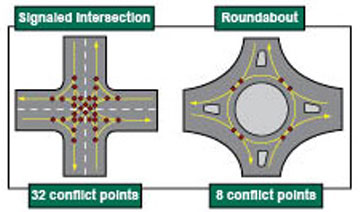
IPFS News Link • Transportation
Traffic go you down? use Roundabouts.
• www.nevadadot.com/Safer than signalized intersections

Intersection safety is a serious traffic problem in the United States. The Federal Highway Administration reports that, in just one recent year, approximately one death occurred every hour nationwide relating to intersections. Over nine thousand people lost their lives in traffic intersections in that recent year, equaling nearly one quarter of all traffic fatalities and amounting to a financial loss of over $96 billion.
As speeds in modern roundabouts are often much slower than in intersections, any potential roundabout crashes are usually at lower speeds, and at less-dangerous angles (such as sideswipe). This translates into less severe injuries and property damage, if any. A study printed in the Transportation Research Record reported that converting 23 test intersections throughout the U.S. from traffic signals to roundabouts reduced injury crashes by 80 percent, and reduced all crashes by 40 percent, in those areas. Results were much the same for similar studies throughout the U.S. and Europe.
Reduces Traffic Delays / Increases Traffic CapacityTraditional traffic signals usually stop two or more directions of traffic at one time. In roundabouts, all directions of traffic are often kept open and safely flowing. Several Insurance Institute for Highway Safety studies report significantly-improved traffic flow when traditional intersections are converted to roundabouts. A study of three such intersections in Nevada, Kansas and Maryland found that traffic delays were reduced 13-23 percent using roundabouts. Similar studies have shown a reduction of up to 89 percent in vehicle delays in roundabouts.
Can slow excessive traffic speeds while still improving traffic flowRoundabouts can effectively and safely slow traffic and improve traffic flow.
Reduced long-term operational costsWith limited or no electrical costs and lower maintenance costs, operational savings from roundabouts have been estimated at an average of $5,000 per year. In addition, the service life of a roundabout is approximately 25 years, versus approximately 10-20 years of service life for traffic signals.
More environmentally-friendly than traditional intersections due to less vehicle emissions, fuel use and noiseMany vehicles must wait for the light to turn green in a signalized intersection. While stopped, the vehicle’s exhaust emits more undesirable pollutants and gases into the atmosphere. Because roundabouts often eliminate such stops and improve traffic flow, they also reduce vehicle emissions and fuel consumption. In one study, replacing traffic signals and signs with roundabouts reduced carbon monoxide emissions by 32 percent, nitrous oxide emissions by 34 percent, carbon dioxide emissions by 37 percent and hydrocarbon emissions by 42 percent. Gasoline use is also reduced as traffic moves more efficiently through roundabouts, without the start and stop found at traditional intersections. Studies have shown that fuel savings can be up to 30 percent in roundabouts. At 10 intersections studied in Virginia, this savings amounted to more than 200,000 gallons of fuel per year. Without the stop and start of traditional traffic intersections, roundabouts can also reduce vehicle noise pollution.
More aesthetically-pleasing than traditional traffic intersectionsParis’ famous Arc De Triomphe monument stands in the middle of what is perhaps the world’s most famous traffic circle. While modern roundabouts are smaller and often easier to navigate than this Paris example, the center circle of many U.S. roundabouts still provide opportunities for unique community gateways and landscaping/aesthetics. As opposed to traffic lights, roundabouts provide an opportunity for landscape and aesthetic improvements that can enhance and define corridors, cities, and tourism.
Fact Five: The modern roundabout is the safest form of intersection control available. This fact has been verified worldwide and in the USA by several recent studies of intersection safety. In a recent Federal Highway Administration publication ("Roundabouts: An Informational Guide." USDOT/FHWA Publication No. FHWA-RD-00-067, Washington, D.C., June, 2000) it is reported that: "experience in the United States shows a reduction in crashes after bulding a roundabout of about 37 percent for all crashes and 51 percent for injury crashes." If only small to moderate single lane roundabouts are considered, the reductions are 51 percent for all crashes. Additionally, reductions are 73 percent for injury crashes. Mean reductions in crashes after converting to a modern roundabout from other traffic control devices have been similar in several other countries: Australia 41-61% for all crashes and 45-87% for injury crashes; France 57 to 78% for injury crashes; Germany 36% all crashes; Netherlands 47% all crashes; United Kingdom 25-39% injury crashes (p. 112, Exhibit 5-9). In probably the most comprehensive US study to date, the Insurance Institute for Highway Safety recently completed an in-depth study of 24 intersections which were converted from stop control and signals to modern roundabouts during the past decade. These 24 intersections were a mix of urban, suburban and rural environments. Overall, the study found reductions of 39% for all crash severities combined, 76% for all injury crashes and an approximate 90% reduction in fatal and incapacity injury crashes ("Crash Reduction Following Insallation of Roundabouts in the United States." Insurance Institute for Highway Safety, Arlington, VA, March, 2000).























1 Comments in Response to Traffic go you down? use Roundabouts.
Social Bridesmaids Modern, glamorous dresses. Junior Bridesmaid Dresses Dresses for pre-teens.